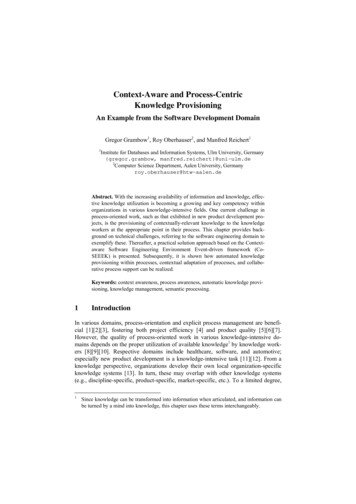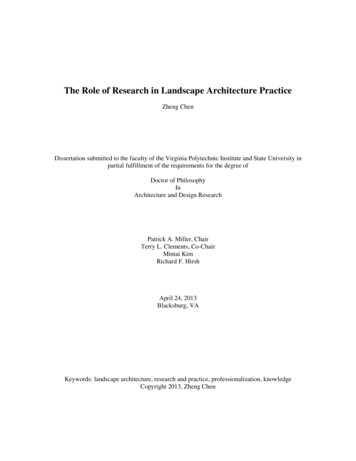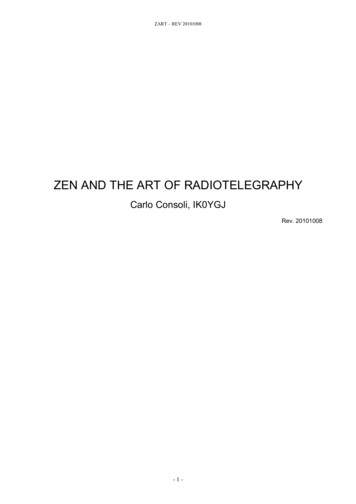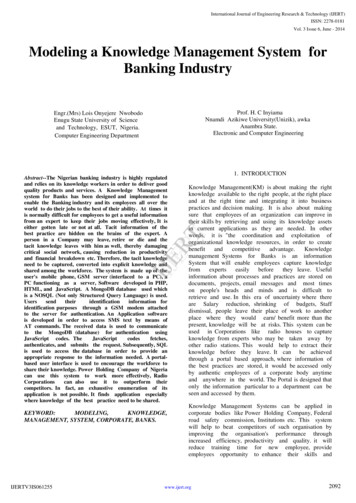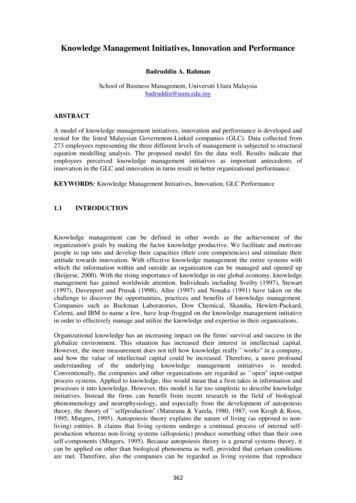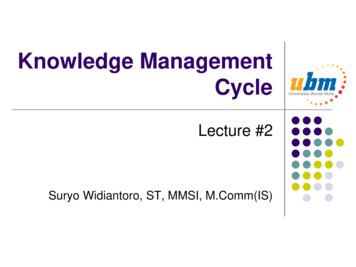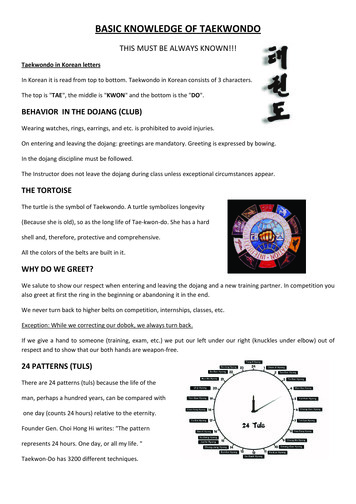
Transcription
BASIC KNOWLEDGE OF TAEKWONDOTHIS MUST BE ALWAYS KNOWN!!!Taekwondo in Korean lettersIn Korean it is read from top to bottom. Taekwondo in Korean consists of 3 characters.The top is "TAE", the middle is "KWON" and the bottom is the "DO".BEHAVIOR IN THE DOJANG (CLUB)Wearing watches, rings, earrings, and etc. is prohibited to avoid injuries.On entering and leaving the dojang: greetings are mandatory. Greeting is expressed by bowing.In the dojang discipline must be followed.The Instructor does not leave the dojang during class unless exceptional circumstances appear.THE TORTOISEThe turtle is the symbol of Taekwondo. A turtle symbolizes longevity(Because she is old), so as the long life of Tae-kwon-do. She has a hardshell and, therefore, protective and comprehensive.All the colors of the belts are built in it.WHY DO WE GREET?We salute to show our respect when entering and leaving the dojang and a new training partner. In competition youalso greet at first the ring in the beginning or abandoning it in the end.We never turn back to higher belts on competition, internships, classes, etc.Exception: While we correcting our dobok, we always turn back.If we give a hand to someone (training, exam, etc.) we put our left under our right (knuckles under elbow) out ofrespect and to show that our both hands are weapon-free.24 PATTERNS (TULS)There are 24 patterns (tuls) because the life of theman, perhaps a hundred years, can be compared withone day (counts 24 hours) relative to the eternity.Founder Gen. Choi Hong Hi writes: "The patternrepresents 24 hours. One day, or all my life. "Taekwon-Do has 3200 different techniques.
THEORY FOR 9 KUP (WHITE / YELLOW BELT)1. Historical Background (TAEKWONDO YOKSA)Taekwondo is no ordinary sport, such as football or tennis. It is a martial art. Therefore, there are certain traditionsand customs of the ancient Asia (in our case Korea) attached to it, therefore, is a certain philosophy behind it. Tobetter understand for what tae-kwon-do actually stands for, here are some important notes about the origins,history, philosophy and principles of this Korean defense art. In the East exists more than one martial art, originallypracticed by monks, farmers, etc., each of them usually had to defend themselves against attackers with bare handsand feet without weapons. Korea was no exception. One of the Korean "martial arts" was Taek Kyon. From 1909 to1945, Korea was occupied by Japan. The rulers tried insist their own martial arts (ex. Judo, karate, etc.), for example,by prohibiting the Korean arts to the Koreans. Though the Korean arts were sometimes practiced in secret tomaintain and to save them for future generations.In 1938, Choi Hong Hi (the person who in 1955 will establish Taekwondo) departed to Japan to study. In two years,he also earned a black belt in karate there. On his return to Korea, he devoted himself to the liberation of hiscountry, and he was arrested and ended up in a Japanese prison. In 1945, Korea was liberated. Choi became alieutenant in the Korean army. Increasingly he realized that Korea had to get back their own martial art. Choi Hong Hibegan developing new techniques and late 1954 was laid the foundation for a new Korean martial art, which wasnamed Taekwondo on April 11, 1955. On the spiritual level is derived from the traditional taekwondo Korean ethicaland moral values.Even if it were taek kyon and karate sometimes used as a reference at the physical level, the techniques based onscientific principles (especially the laws from physics) shows that Taekwondo is different martial art (ex. wave motionand the relationship strength-relaxation.)Meanwhile, Choi became General, so that he could introduce his sport first to the army.In 1966 (April 22), the International Taekwondo Federation (ITF) was established. As aresult of the political pressure and the growing frictions between North and South Korea,General left again his homeland in 1972; he settled in Canada.In South Korea WTF (World Taekwondo Federation) was founded in response. Both forms of taekwondo have thesame base but they are so grown apart, that the differences are greater than the similarities.The General with the evolution of the times and the changing needs of society made more adjustments. The ITFTaekwondo was not only under the influence of its founder, it is an evolving sport also. On June 15, 2002 GeneralChoi died. Master Tran Trieu Quan (VIII degree then) was elected president of ITF. The present President of ITF isCHANG UNG.In a summary:Taekwondo was founded in 1955 in Korea by General Choi Hong Hi, on April 11; it was the first time when the name"Taekwondo" was used. ITF was founded in 1966. Tae-kwon-do has approximately 3,200 techniques.2. Meaning of TI (belt)White belt signifies innocence like a beginner who has no prior knowledge of Taekwondo.How correctly to tie up a belt please follow instructions in the image below.
3. VocabularyCHARYOTmeansattentionKYONGE YEmeansgreeting/bow; 15 degrees to bendJUMBImeansreadySI meansrelaxHAESANmeansend of leftORUNmeansrightNADJUNDEmeanslow sectionKAUNDEmeansmidsectionNOPUNDEmeanshigh section
STANCES (SOGI)Ready stance - Junbi SogiTae-kwon-do has many modes, which emerge in the patterns. The ready stance is not partof an action, but is a position from which the student movement starts. It is that theposition is ideal for increasing the concentration.Attention stand - Charyot SogiThis is the position used for attention, before and after exercise.1. Feet form an angle of 45 degrees.2. Drop fists down naturally. The elbows are slightly curved/bended.3. The fists are clenched slightly.4. The eyes look forward, just above the horizontal line.Bending Attitude - Kyong Ye JaseThis is the attitude and the movement that one has to makewhen greeting teacher, fellow student, jury and opponentduring competitions:Bend the body 15 degrees forward.Keep looking into the opponent's eyes.Parallel stance - Narani sogiSpread the feet parallel to shoulder width.The toes need to be pointing forwards.Walking stance - Gunnun SogiThis is a strong position, both front and rear feet are offensive anddefensive. Move one of feet forward or rear. The length betweenboth feet should be shoulder and half width , while the width betweenboth feet is one shoulder width. A stand with a length longer than aone and a half shoulder width makes the movement slow and one isvulnerable to attack from the side, front or back. Bend the front legso that the heel in a straight aligns with the knee. The rear leg has to be completely stretched. Distribute yourbody weight equally on both feet. Make sure the toes of the front foot pointing forward. The toes of the backleg foot must be pointed 25 degrees outwards When this is greater than 25 degrees then is more vulnerableto the rear leg an attack from behind. Tighten the muscles of both feet with the sense to bring them together.
L-stance - Niunja SogiThis mode is widely used in the defense, but for the offensive stand alsouseful. The front foot is in place to give a kick. Therefore, only a smalldisplacement of the body weight needed to make. Move foot eitherforward or backwards, so that the length between both feet is slightlyless than about a shoulder width. There is almost a straight angle formed. It is recommended to both feet about 15degrees to allow point, within a result, a better stability is obtained. Bend the back leg so far until the knee in astraight line forms with the toes, proportionally bent front leg. Ensure that the hip remains in a line with the innerknee joint. The distribution of the body weight is 70 percent on the rear leg and 30 percent on the front leg.Sitting position - Annun SogiThis is a very stable position for a lateral movement. This mode is alsowidely used for impact/punching exercises and for the legs muscledevelopment. One of the major advantages of this mode is that you canshift into walking stance without relocating feet. Spread one of thetwo legs to the side at a distance of one and a half shoulder width between the two toes. Make sure the toespointing forward and body weight equally distributed on both legs. Stretch the knees outward, bending until theknee is over the ball of the foot. Tighten the muscles in the thighs and increases strength in the legs pulling foot solesto side. Finishing a movement over the ground, push the chest and abdomen forward and push the hips backwardswhile the belly (muscle) are tightened. Do not make the stance too wide, as speed and agility will dramaticallydecrease. The stance may executable with a full face or side facing, both in attack and in defense.Hand Techniques (SON GISOOL)JIRUGImeanspunchJOOMUKmeansfistAP JOOMUK JIRUGImeanspunch forwardSONKALmeansknife handMAKGImeansblock or defenseNADJUNDE SONKAL MAKGImeanslow knife hand blockPALMOKmeansforearmAN PALMOK MAKGImeansinside forearm blockNADJUNDE PALMOK MAKGImeanslow forearm blockAP MAKGImeansforward block - from outside to insideCHUKYO MAKGIFoot techniques (BAL GISOOL)meansupward block
CHAGImeanskickOLLIGImeansrisingAP CHAGImeansfront kickDOLLYO CHAGImeansroundhouse/turning kickYOP CHAGImeansside kickNAERYO CHAGImeansdownward kickDWIT CHAGImeansbackward kickAP CHA OLLIGImeansfront rising kickYOP CHA OLLIGImeansside rising kick4. Knowledge of TaekwondoFormal titles1st to 3rd Danis calledAssistant Instructor (Boosabum)4th to 6th Danis calledInstructor (International Instructor) (Sabum)7th to 8th Danis calledMaster (SAHYUN)9th Danis calledGrand Master IlgobYudolAhopYeolPatterns (Tul)With patterns movements’ taekwondo set itself an imaginary fight for which both attacking and defensivetechniques are used. There are 24 tuls in Taekwondo. The white belt teaches no real Tul, but teaches preparatorymovements: SAJU JIRUGI (4 sides attack) and SAJU MAKGI (4 sides defensive).Tips:Pattern must start and end at the same place.Always correct posture, position, and composition.The muscles of the body are completely relaxed after each movement n and tense during themovement.Perform Rhythmic movements not run stiff.Both the left and right hand versions equally powerful.Perform each movement with a sense of realism.
What is Taekwon-do?TAE: Stands for all foot and leg techniques both attack and defense can be implemented.KWON: Stands for all hand and fist techniques both attack and defense can be implemented.DO: Literally means the "way" the "art", and is accompanied by a certain mental attitude namely: courtesy, integrity,indomitable spirit, perseverance and self-control.Principles/Tenets of Taekwondo (meaning of "do")CourtesyIntegritySelf-controlIndomitable spiritPerseveranceThe oath of Taekwondo (Kwaran soon soo)I shall observe the tenets of Taekwondo.I shall respect my instructors and seniors.I shall never misuse taekwondo.I shall be champion of freedom and justice.I shall build a more peaceful world.SUBJECTS TO KNOW FOR EXAM 9TH KUPBasic knowledge of TaekwondoKnow how Taekwondo was createdKnow when and by whom Taekwondo was createdMeaning of WHITE beltTo name (in Korean) all learned punches, blocks, kicks and stances, to show them and explainCorrectly perform SAJU JIRUGI (4 direction punch)Correctly perform SAJU MAKGI (4 directions block)To know and name titles of black belts (Dans)To know meaning of TaekwondoThe 5 principles/tenets of the "DO": to name them explain and understandTo know the Oath of Taekwondo and be able to say it in right orderTo be able fight without contact with partner for 2 min to demonstrate different techniques learned.
THEORY FOR 8 KUP (YELLOW BELT)1. Historical Tul Background (TAEKWON-DO YOKSA)"CHON-JI" literally means "heaven and earth". It is interpreted in the East as the creation of the world and thebeginning of human history. Therefore this first Tul performed by beginners. The Tul consists of two parts, the firstpart for heaven and the second for the earth. It contains 19 moves!REMEMBER at the end: Bring the left foot back to NARANI SOGI2. Meaning of TI (belt)Signifies earth from which the plant takes root and sprouts as Taekwondo foundation is laid.3. VocabularyGeneral termsDWIRO OMGYO DIDIMYO DOLGImeansbackwards step turn (rotation In Chon-Ji)MIKULGImeanssliding for long distanceJAJUN BALmeanssliding short distance/Foot shifting (one orboth feet shifting)STANCES (SOGI)NoneHand Techniques (SON GISOOL)NADJUNDE BAKAT PALMOK MAKGImeanslow outer forearm block(1st movement in Chon-Ji)AN PALMOK MAKGImeansinner forearm block (9th movement inChon-Ji)KAUNDE AP JOOMUK JIRUGImeanscenter forward fist punch (2nd movementin Chon-Ji)Foot techniques (BAL GISOOL)None4. Knowledge of TaekwondoThe magic number 9:One starts with 9th kup and ends 9th Dan in Taekwondo because 9 is a magicnumber for the Asians. Multiply it by any other number is the sum of the digitsis always 9. Ex.: 9 x 112 1008 the sum of digits: 1 0 0 8 9.
The number 9 is in the East is an important sacred number. Moreover, it is mysterious, because it keeps comingback.SparringA Taekwondo fight on competition will be decided by points and takes two minutes. There are four corner refereeswho give points and one ring referee on the field provided.The points are allocated as follows:1 point for all fist techniques on the body or face2 points for all leg techniques on the body3 points for all leg techniques on the faceWarningsUi Ju Hanna: before an warning is given, the fight is stopped ( heachyo) and then to the accused person a warning isattributed. In three warnings, one point is deducted.Gam Jum Hanna, a minus point you can get through full-contact (too hard, usually uncontrollably) or a falling downor ignoring umpire commands. Three direct minus points disqualification (Sil Kyuk).You get a warning if you:PushKicks below the beltGrabing opponentPerforming a technique on the backDeliberately avoids battle (running away)Fall down (touch by hand on ground)Goes out of the ringAttacks without lookingturn awaytalksClaims provoking pointMatsugi (step sparring)Taekwondo students learn the techniques of Matsugi that are taught during tuls to learn how to apply them insparring. There are three types Matsugi: Sambo Matsugi (three step sparring), Ibo Matsugi (two-step sparring) and Ilbo Matsugi (one step sparring). For the yellow belt exam, candidates must perform five three steps. This is done inpairs.Methodology
You stand facing each other, bow to each other, then the attacker (pre-arranged) measures the distance needed toperform attack. After that, the attacker with his right leg goes backward in gunnun sogi palmok najundi makgi. This isthe initial position in which each three-step is carried out.In theory, the defender determines which attack will be performed, but for practical reasons (on the distancebetween the performers), we recommend that the attacker decides which attack he will be performing. After all,knows beforehand what technique he will use).Once the attacker has called the technique, he states that he is ready to attack ("TSE"). The defender ponders whattechnique he will use to defend and indicates that he is ready ("TSE"). The defender may take his time to getprepared for.Afterwards the attacker kick or punch and the defender defends/blocks three times. The defender then performs acounterattack.Then reverse roles. The attacker brings his front leg back to NARANI SOGI (ie backwards) and the defender brings hishind leg forward to NARANI SOGI. Now it's up to the person who has just defended for to attack.Attention to:It is important to set the feet in the right place. In an attack in niunja sogi's attacker feet are placed on the outside ofthe feet of the defender. If an attack is in gunnun sogi the foot of the attacker placed on right of the foot of thedefender, so first on the outside and second time on the inside.The defender performs a counterattack depending on the distance between the two people. If the distance is largethere may be a kicking technique to be used; it is recommended to have a hand technique at a short distance.SUBJECTS TO KNOW FOR EXAM 8TH KUPBASIC KNOWLEDGE OF TAEKWONDOALL KNOWLEDGE FROM THE EXAMS IN THE PASTMEANING OF "CHON-JI" TULMEANING OF YELLOW BELTTO NAME (IN KOREAN) ALL LEARNED PUNCHES, BLOCKS, KICKS AND STANCES, TO SHOW THEM AND EXPLAINCORRECTLY PERFORM SAJU JIRUGI (4 SIDES ATTACK)CORRECTLY PERFORM SAJU MAKGI (4 SIDES BLOCK)CORRECTLY PERFORM "CHON-JI" TULCORRECTLY PERFORM 5 DIFFERENT SAMBO MATSOGI'S (THREE STEP SPARRING)2 MIN SPARRING WITH PARTNER WITHOUT CONTACT. PURPOSE: TO SHOW DIFFERENT TECHNIQUES LEARNED INTHE FIGHTING
THEORY FOR 7 KUP (YELLOW/GREEN BELT)1. Historical background Tul (TAEKWONDO YOKSA)"DAN GUN", is named after the holy Dan Gun, the legendary founder ofKorea in the year 2333 BC. This pattern contains 21 movements.END: Bring the left foot back to NARANI JUNBI SOGI.2. Meaning of TI (belt)N/A3. VocabularyGeneral termsBARO JIRUGIright punchBANDAE JIRUGIreverse punchANUROopen body (inner arm)BAKUROclosed body (outside of the arm)STANCES (SOGI)NoneHand Techniques (SON GISOOL)SONKAL DAEBI MAKGIknife-protective block(1st movement in Dan-Gun)PALMOK DAEBI MAKGIforearm protective BlockNOPUNDE AP JOOMUK JIRUGIhigh forward fist punchNADJUNDE BAKAT PALMOK MAKGIlow outer forearm blockSANG PALMOK MAKGItwin forearm block(9th movement in Dan-Gun)BAKKAT PALMOK CHOOKYO MAKGIouter forearm rising block(14th movement in Dan-Gun)KAUNDE SONKAL YOP TAERIGImiddle knife hand side strike(18th movement Dan-Gun)Foot techniques (BAL GISOOL)GORO CHAGIangle or hook kickBANDAE DOLYO CHAGIreverse twisted roundhouse/turning kickAP CHA BUSIGIforward rapidly retreating kick4. Knowledge of TaekwondoKorean "Grammar"
Now you already know some definitions in Korean, so we can say exactly what we performing and whattechnic we performing.We try a translate:Ex. 1: 1st movement of SAJU JIRUGI: orun gunnun so ap jumok kaunde baro ap jirurgi-Literal translation:right front stance with forward punch in the middle section with support arm and leg on the same side.Ex. 2: the last movement of Dan-Gun: wen niunja so sonkal kaunde bandae Bakuro taerigi-Literaltranslation: left L-stance with knife hand stroke in the midle section from the inside out.RULE:There is an order. Using it everything is clearer.1.Firstly goes sides (orun / wen)2.Secondly goes positions (gunnun so, niunja so .)3.Thirdly goes strike or block4.Fourthly goes height of targeting action(5).Fifthly goes baro / bandae (not always used)6.Sixthly goes direction and type of strike/blockAnuro / BakuroANURO:From the outside to the insideBAKURO:From the inside outBaro / BandaeRules in GUNNUN SOGI:BARO: support arm and leg on the same sideBANDAE: support arm and leg on the opposite sideIn NIUNJA SOGI applies:BANDAE: support arm and leg on the same sideBARO: support arm and leg on the opposite sideSUBJECTS TO KNOW FOR EXAM 7TH KUPBASIC KNOWLEDGE OF TAEKWON-DO KNOWALL PREVIOUS KNOWLEDGE THAT YOU HAVE EVER BEEN LEARNEDMEANING OF "DAN-GUN"NEW TECHNICS TO KNOW, BE ABLE TO SHOW AND EXPLAINEXPLAIN WHAT "ANURO" AND "BAKURO" MEANSEXPLAIN WHAT "BARO" AND "BANDAE" MEANSCORRECTLY PERFORM "CHON-JI" TULCORRECTLY PERFORM "DAN-GUN" TULCORRECTLY PERFORM 10 DIFFERENT SAMBO MATSOGI's (Three step sparring)2 MIN FIGHT WITH A PARTNER WITHOUT CONTACT FOR PURPOSE: TO DEMONSTRATEDIFFERENT LEARNED TECHNIQUES DURING A FIGHT
THEORY FOR 6 KUP (GREEN BELT)1. Historical background Tul (Taekwondo YOKSA)"DO-SAN" is the pseudonym of the patriot AHN CHANG HO (1876-1938).The 24 movements represents his entire life which he devoted to furthering theeducation of Korea and its independence movement.END: Bring the right foot back to NARANI JUNBI SOGI.2. Meaning of TI (belt)Green: The color of the plant that grows and develops, as the skill increases in taekwon-do.3. VocabularyGeneral termsNoneSTANCES (SOGI)NoneHand Techniques (SON GISOOL)NOPUNDE BAKKAT PALMOK YOP MAKGIin Do-San)SUN SONKUT TULGISan)NOPUNDE DUNG JOOMUK YOP TAERIGISan)NOPUNDE BAKKAT PALMOK HECHYO MAKGImovement in Do-San)KAUNDE SONKAL YOP TAERIGIhigh outer lateral forearm block(1st movementvertical fingertip attack (6th movement in Dohigh side behind fist blow (8th movement in Dohigh outer forearm splitting block (14thmiddle knife hand side strikeFoot techniques (BAL GISOOL)TWIMYOjumpBANDAE NAERYO CHAGIreverse downward kickTWIMYO DOLLYO CHAGIjumped twisted roundhouse/turning kickTWIMYO YOP CHAGIjump side kickTWIMYO GORO CHAGIjumped angle or hook kick4. Knowledge of TaekwondoThe phases of a movementIn TUL and MATSUGI it is important to finish well executed techniques. Therefore, we see a technique acloser look. Ex: we perform ORUN GUNNUN SOGI, NAJUNDE BAKKAT PALMOK MAKGI. The first
phase is the preparatory phase: we progress forward and we put the defense. During this phase, we use anundulating motion to develop speed.The second phase is the moment of impact: this is the moment when with the part of the body that performsthe defense the object to be blocked, is hit. At the time of the impact our body is tensed in order to pass onthe power and speed which we have developed, through the part of the body that carries out the blocking, tothe object to be blocked.In short, we need to move that we developed in the first phase to the end.It is important that both the motion with the legs and the arm movement and respiration at the same timeholding up. Only in this case it is possible to carry out a powerful technique.The final phase is the phase of the relaxation of the muscles because the defense has already happened. Justlike the muscles are relaxed we can use the next move.THE DYNASTIESCurrent North and South Korea earlier consisted of three dynasties: the Koguryo, Baekje and Silla Dynasty.Koguryo (37 B.C. to 668 A.D.)Paekje (18 to 600 B.C. A.D.)Silla (57 to 935 B.C. A.D.)Silla unified the kingdoms together by winning the war againstPaekje in 660 AD and Koguryo in 668 AD. What followed wasa time of peace and HwaRang grew a military organization toa group specialized in poetry and music.In 936 AD when Wang Kon founded the Koryo dynasty, anabbreviation of Koguryo. The Korea KoryoIn name derivesfrom the Silla Dynasty, the principles of Taekwondo began asthe youth group Hwarang DO. At that time was called the martialthat this group performed albeit still Taekyon and SOO BIN GIbecause of the name "Taekwon-do 'was still a long way.Modern Taekwondo is a combination of many other martialarts. The most important of these is the Japanese Karate.This is because Japan occupied Korea from 1910 to the endof the 2nd World War II. during the WWII, lots of Koreansoldiers were trained in Japan. This occupation Japan triedall traces of Korean culture, including to eliminate thetraditional martial arts. The influence that the Karate to the Taekwondo has enriched the quick, linearmovements that characterize the various Japanese.After World War II, when Korea became independent, several kwans arose. These were:· Chung Do Kwan· Moo Duk Kwan· Yun Moo Kwan· Chang Moo Kwan· Oh Do Kwan· Ji Do Kwan· Chi Do Kwan· Song Moo KwanThe Kwan united in 1955 as Tae Soo Do. In the beginning of 1957, the name Taekwondo was set equal to the nameTae Kyon by several Korean martial arts masters.General Choi Hong-Hi required the army to train Taekwondo. Thus the first Korean soldiers were Taekwondostudents. The police and air force had to learn Taekwondo. At that time Taekwondo was merely a Korean version ofShotokan Karate.
SUBJECTS TO KNOW FOR EXAM 6TH KUPBASIC KNOWLEDGE OF TAEKWON-DO KNOWALL PREVIOUS KNOWLEDGE THAT YOU HAVE EVER BEEN LEARNEDMEANING KNOWING THE "DO-SAN"MEANING OF THE GREEN BELTNEW TECHNICS TO KNOW, BE ABLE TO SHOW AND EXPLAINTO NAME THE VARIOUS DYNASTIES WHO WERE IN KOREACORRECTLY PERFORM "DAN-GUN" TULCORRECT TO PERFORM "DO-SAN" TULCORRECTLY PERFORM 12 DIFFERENT SAMBO MATSOGI's (Three step sparring)2 MIN SPARING WITH A PARTNER WITHOUT CONTACT. PURPOSE: TO DEMONSTRATE DIFFERENTTECHNIQUES DURING A FIGHT
THEORY FOR 5 KUP (GREEN/BLUE BELT)1. Historical background Tul (TAEKWONDO YOKSA)"WON-HYO" was the name of the monk who introduced Buddhism to the Silla Dynasty in the year 686 AD.END: Bring the right foot back to MOA SOGI A2. Meaning of TI (belt)None3. VocabularyGeneral termsNoneSTANCES (SOGI)CLOSED POSITION - MOA SOGIA position held with the feet down together. Possible executable withfull face or a side facing. Many of the 24 patterns, starting with thisposition.FIXED POSITION (EXTENDED L-MODE) - GOJUNG SOGIThis is an effective mode to work out for an attack or goto the side. This position is equal to the short mode with thefollowing exceptions:· Body weight is evenly distributed on both legs.· The distance between both feet shoulder width to one half to be.When the right leg for this position is a right fixed stance is called and when the left leg is a left fixedposition. The stand is always performed in a side facing.BENT POSITION - GUBURO SOGIThis position serves as a preparatory position for backwardand lateral steps, generally defensive movements. While standingon the right leg, there is a right flexed position, vice versa.The position possible executable with a full face or side facing.Hand Techniques (SON GISOOL)SANG PALMOK MAKGINOPUNDE SONKAL ANURO TAERIGIKAUNDE SONKAL DAEBISUN SOLKUT TULGIAN PALMOK DOLLYMIO MAKGIKAUNDE PALMOK DEABI MAKGIFoot techniques (BAL GISOOL)twin forearm blockhigh knife hand inward stroke (2nd movement in WON-HYO as awareness)middle knife hand MAKGI block protectingvertical fingertip outagesinside forearm circular defense (19th movement in WON-HYO as awareness)middle forearm protective blockNone4. Knowledge of TaekwondoMATSUGIFor the exam, the student must perform 12 SAMBO MATSUGI program. In addition, the student must beable perform 5 IBO MATSUGI (two step sparring). The difference with the three-step consists in themethod of attack: in contrast to the three step sparring, where the attacker attacked three times with the sameattack, the attack is two-step sparring is in two different attacks; a kick and a punch, or vice versa.
Similarly, the starting position, in which the attacker starts, is different from the SAMBO MATSUGI.Instead of a GUNNUN SOGI PALMOK NAJUNDE MAKGI, the attacker begins in NIUNJA MAKGIPALMOK DAEBI MAKGI.BREAK TECHNIQUES OR KYEK PAMany think that the basic shape and size needed to break a board. But that is not so. There different things tolook at. Here are the factors which lead to a higher degree of physical strength.Action-Reaction: Every force has an equal and opposite force. Therefore, in taekwondo with every move thehand quickly withdrawn to the hip.Concentration: The maximum power is only given at the time of impact.Balance: The body is balanced with each technique. This can be done by a proper position to take.Breathing: The control of breathing not only affects the speed and power. It can also prepare the body for afight. Never breathe in the moment of the impact!Wave motion: Relationship strength - relaxation.Speed: Speed is the most essential factor when invoking force or pressure.Scientifically, force equals mass times accelerationForce mass x speed.Must to knowThe bursting test must be passed with 1.5 to 3.5 cm wide pine plank of wood the size of 30x30 cmHow to proceed?Come to the place, than greet.Measure the distance down to the shelf. Take a good distance, certainly not too short.Breathe in and out. Measure one more time the distance.Come in JUMBI.Break the shelf.Come back in JUMBI.Greeting.Note:Always be peaceful and calm. Remember, use your whole body. You break the board with your hips, shouldersGet it off your power. Also remember that you not would, but should hit the shelf.
SUBJECTS TO KNOW FOR EXAM 5TH KUPBASIC KNOWLEDGE OF TAEKWON-DO KNOWALL PREVIOUS KNOWLEDGE THAT YOU HAVE EVER BEEN LEARNEDMEANING OF KNOWING "WON-HYO"NEW TECHNICS TO KNOW, BE ABLE TO SHOW AND EXPLAINCORRECT TO PERFORM "DO-SAN" TULCORRECT TO PERFORM "WON-HYO" TULCORRECT TO PERFORM 12 DIFFERENT SAMBO MATSOGI's (Three step sparring)CORRECT TO PERFORM 5 DIFFERENT MATSOGI IBO's (Two step sparring)2 MIN SPARRING WITH A PARTNER WITHOUT CONTACT. PURPOSE: TO DEMONSTARTAE DIFFERENT TECHNIQUESDURING A FIGHTBREAK TEST: 2 BREAK TECHNIQUES PERFORMING ON A WOODEN SHELF OR HERBREEKBARE SHELF1ST TECHNOLOGY: AP CHAGI (or NOPI CHAGI)2ND TECHNIQUE: SONKAL TAERIGI
THEORY FOR 4 KUP (BLUE BELT)1. Historical background Tul (TAEKWONDO YOKSA)"YUL-GOK" is the pseudonym of the great philosopher and scholar YI 1 (1536 - 1584) nicknamed"The Confucius of Korea." The 38 movements refer to his birthplace on 38 latitude and the diagram of Tul meaning"scholar" ( )END: Bring the left foot back to NARANI JUNBI SOGI2. Meaning of TI (belt)Blue belt signifies the heaven towards which plants matures into a towering tree as knowledge in Taekwondoincreases.3. VocabularyGeneral termsNoneSTANCES (SOGI)X-STANCE - KYOCHA SOGIThis is a very well usable position to attack the front or the side of an opponent.The stand is used in some cases, blockages, but generally it must standas preparation for the move to the next maneuver. Cross one foot behind the other, whereby the backfoot is soft contact with the ground. Place the weight on the front leg.When the body weight on the right leg, there is a right X-stance, vice versa.The stance possible executable with a full face or side facing, both in attack and in defense.Hand Techniques (SON GISOOL)KAUDE AN PALMOK MAKGIKAUNDE SONBABAK GOLCHO MAKGIAP PALKIUP TAERIGISANG SONKAL MAKGIKAUNDE SUN SONKUT TULGINOPUNDE BAKAT PALMOK YOP MAKGIDUNG JOOMUK YOPDWI TAERIGINOPUNDE DOO PALMOK MAKGImiddle inner forearm blockmiddle palm corner block (hold YUL-GOK)forward stroke elbow (elbow YUL-GOK)twin knife-blockmiddle fingertip strikehigh outer forearm lateral blockback fist side strike (jump YUL-GOK)high double forea
Taekwondo was founded in 1955 in Korea by General Choi Hong Hi, on April 11; it was the first time when the name "Taekwondo" was used. ITF was foundedin 1966. Tae-kwon-do has approximately 3,200techniques. 2.MeaningofTI(belt) White belt signifies innocence like a beginnerwho has no prior knowledge of Taekwondo.
